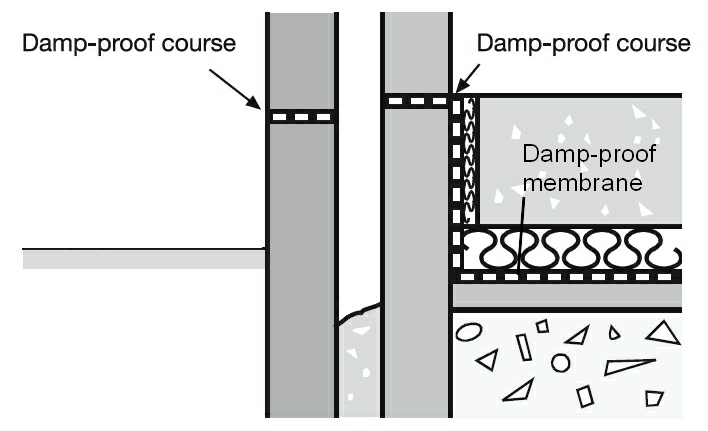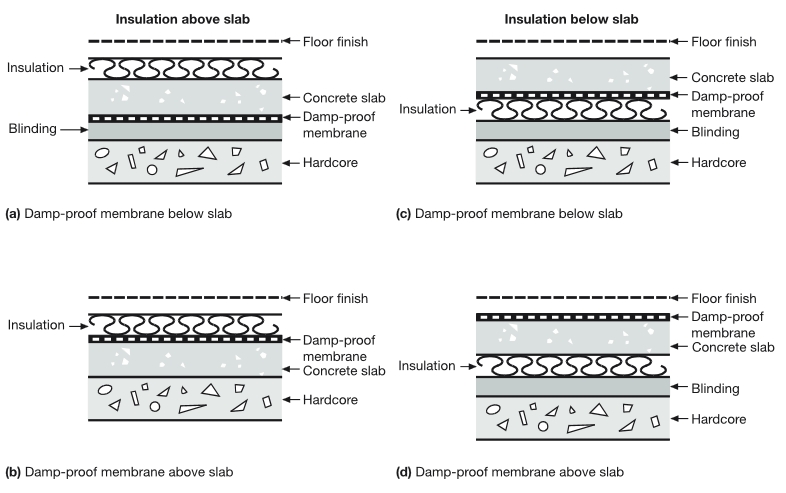Damp proof membrane DPM
Contents |
[edit] What problems does damp cause in buildings?
Damp in buildings can cause a number of serious problems, such as:
- Damp patches.
- Mould growth, which is a cause of respiratory allergies.
- Mildew, salts, staining and ‘tide marks’.
- Damage to surface finishes.
- Corrosion and decay of the building fabric.
- Slip hazards.
- Frost damage.
- Poor performance of insulation.
- Damage to equipment, or electrical failure.
[edit] What are the causes of damp in buildings?
The most common causes of persistent damp in buildings are:
- Surface condensation.
- Interstitial condensation (condensation within the fabric of a building's construction, either on the surfaces of components that make up the fabric, or sometimes within the components themselves).
- Penetrating damp.
- Rising damp.
[edit] What regulates the requirement for a damp proof membrane?
Approved document C, Site preparation and resistance to contaminants and moisture, requires that (where appropriate) floors next to the ground should:
- Resist the passage of ground moisture to the upper surface of the floor.
- Not be damaged by moisture from the ground.
- Not be damaged by groundwater.
- Be designed and constructed so that their structural and thermal performance are not adversely affected by interstitial condensation.
- Should not promote surface condensation or mould growth.
[edit] What is a damp proof membrane?
A damp proof membrane (DPM) is a thin, sheet material used to prevent moisture transmission. Typically, a damp proof membrane is a polyethylene sheet laid under a concrete slab to prevent the concrete from gaining moisture from the ground by capillary action.
The approved document suggests that a ground-supported floor will meet these requirements if the ground is covered with dense concrete laid on a hardcore bed and a damp proof membrane is provided. It suggests that the damp proof membrane may be above or below the concrete, and continuous with the damp proof courses (DPCs) in walls, piers, and other structures.
If the ground could contain water soluble sulphates, or there is any risk that sulphate or other deleterious matter could contaminate the hardcore, the membrane should be placed at the base of the concrete slab.
The approved document proposes that:
- A membrane below the concrete could be formed with a sheet of polyethylene, which should be at least 300μm thick (1200 gauge) with sealed joints and laid on a bed of material that will not damage the sheet.
- A membrane laid above the concrete may be either polyethylene sheet as described above (but without the bedding material) or three coats of cold applied bitumen solution or similar moisture and water vapour resisting material. It should be protected by either a screed or a floor finish, unless the membrane is pitchmastic or similar material which will also serve as a floor finish.
In order to resist degradation, insulation placed below the damp proof membrane should have low water absorption. If necessary the insulant should be resistant to contaminants in the ground.
A timber floor finish laid directly on concrete may be bedded in a material which may also serve as a damp-proof layer. Timber fillets laid in the concrete as a fixing for a floor finish should be treated with an effective preservative unless they are above the damp-proof membrane.
[edit] Related articles on Designing Buildings
- Basement waterproofing.
- Bitumen.
- Blinding.
- Breather membrane.
- Capillary action.
- Cavity tray.
- Chemical injected DPC.
- Damp.
- Damp proof course.
- Damp proofing.
- Does damp proofing work?
- Dew point.
- Humidity.
- Insulation.
- Interstitial condensation.
- Penetrating damp.
- Polyethylene.
- Rising damp.
- Types of damp-proof courses.
- Vapour barrier.
Featured articles and news
RTPI leader to become new CIOB Chief Executive Officer
Dr Victoria Hills MRTPI, FICE to take over after Caroline Gumble’s departure.
Social and affordable housing, a long term plan for delivery
The “Delivering a Decade of Renewal for Social and Affordable Housing” strategy sets out future path.
A change to adoptive architecture
Effects of global weather warming on architectural detailing, material choice and human interaction.
The proposed publicly owned and backed subsidiary of Homes England, to facilitate new homes.
How big is the problem and what can we do to mitigate the effects?
Overheating guidance and tools for building designers
A number of cool guides to help with the heat.
The UK's Modern Industrial Strategy: A 10 year plan
Previous consultation criticism, current key elements and general support with some persisting reservations.
Building Safety Regulator reforms
New roles, new staff and a new fast track service pave the way for a single construction regulator.
Architectural Technologist CPDs and Communications
CIAT CPD… and how you can do it!
Cooling centres and cool spaces
Managing extreme heat in cities by directing the public to places for heat stress relief and water sources.
Winter gardens: A brief history and warm variations
Extending the season with glass in different forms and terms.
Restoring Great Yarmouth's Winter Gardens
Transforming one of the least sustainable constructions imaginable.
Construction Skills Mission Board launch sector drive
Newly formed government and industry collaboration set strategy for recruiting an additional 100,000 construction workers a year.
New Architects Code comes into effect in September 2025
ARB Architects Code of Conduct and Practice available with ongoing consultation regarding guidance.
Welsh Skills Body (Medr) launches ambitious plan
The new skills body brings together funding and regulation of tertiary education and research for the devolved nation.
Paul Gandy FCIOB announced as next CIOB President
Former Tilbury Douglas CEO takes helm.
UK Infrastructure: A 10 Year Strategy. In brief with reactions
With the National Infrastructure and Service Transformation Authority (NISTA).

























Comments
[edit] To make a comment about this article, or to suggest changes, click 'Add a comment' above. Separate your comments from any existing comments by inserting a horizontal line.